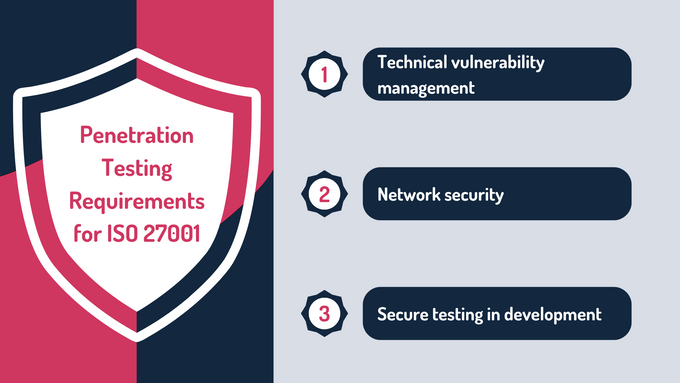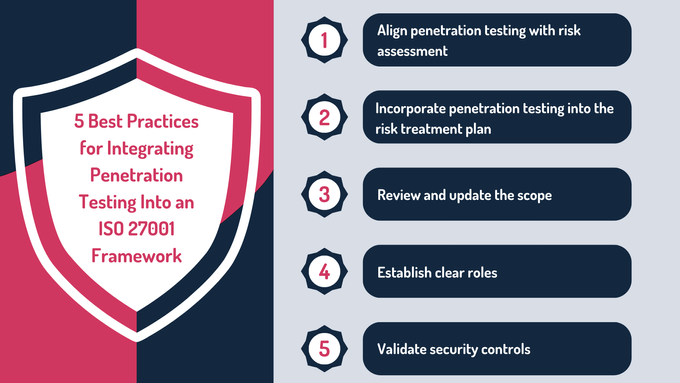ISO 27001 Penetration Testing: Requirements and Best Practices
Understand the key ISO 27001 pentesting requirements and best practices for achieving and maintaining compliance.
Published April 5, 2025.

Meeting ISO 27001 penetration testing requirements is a crucial step in maintaining a strong security posture and achieving compliance. Ensuring that penetration tests align with ISO 27001 standards requires careful planning, proper documentation, and ongoing risk management. From selecting the right testing approach to integrating findings into security processes, organizations must take a structured approach to meet audit expectations.
This guide explores the essential ISO 27001 pentesting requirements, best practices for conducting tests, and how to maintain compliance over time.
» Let the experts handle your penetration testing needs with our startup and enterprise services
What Is ISO 27001?
ISO 27001 is an international standard for information security management systems (ISMS), providing a framework to manage and mitigate risks to information assets. It emphasizes risk assessment and treatment through security controls.
» Still comparing frameworks? See our guide to SOC 2 vs. ISO 27001
How Does Penetration Testing Fit Into the 27001 Framework?
Although penetration testing is not explicitly mandated, it fits into this framework by helping organizations identify vulnerabilities and assess the effectiveness of their security controls.
This process supports the risk management process outlined in ISO 27001, particularly in Annex A controls, ensuring that an organization's ISMS is robust and compliant with the standard's requirements for protecting confidentiality, integrity, and availability of information.
» Understand how penetration testing can fortify your cybersecurity
Controls Related to Penetration Testing in ISO 27001
Annex A outlines various controls that contribute to a strong security posture, with penetration testing serving as a key method for assessing their effectiveness. It helps organizations proactively detect vulnerabilities and strengthen defenses. These controls include:
- A.12.6.1—Technical vulnerability management: This control emphasizes the need to identify, evaluate, and mitigate technical vulnerabilities, which penetration testing can effectively support by simulating attacks to identify exploitable vulnerabilities.
- A.8.9—Configuration management: This control ensures that system configurations remain secure against potential threats. Penetration testing can identify vulnerabilities resulting from improper configurations, such as default settings, unnecessary open ports, or misconfigured security settings, which could be exploited by attackers.
- A.8.20—Network security: This control helps ensure that network protections are functioning as intended. Penetration testing is essential here to test network defenses, including firewalls, intrusion detection/prevention systems, and access controls.
- A.8.21—Security of network services: This control assesses the security of communication channels and connected services.
» Learn more about securing your networks with penetration testing: Internal, external, and wireless
Types of Penetration Testing for ISO 27001 Compliance
All three approaches—black box, white box, and gray box testing—can be effective for ISO 27001 compliance. The choice depends on the organization's specific needs and risk profile.
Types of Penetration Testing
- Black box testing simulates an external attacker with no prior knowledge of the system.
- White box testing provides the tester with full knowledge of the system's architecture, code, and configurations.
- Grey box testing offers a hybrid approach, providing the tester with partial knowledge of the system.
Gray box testing is often preferred, as it combines both black box and white box techniques, offering a comprehensive view of both external and internal vulnerabilities.
» Want to learn more? Discover the different types of penetration tests
Penetration Testing Requirements for ISO 27001
Annex A highlights the importance of security testing to manage risks and ensure a robust defense against threats. Below are key penetration testing requirements and the standards they must follow.
Control A.12.6.1: Technical Vulnerability Management
- Requirement: Organizations must identify, evaluate, and mitigate technical vulnerabilities in a timely manner. Penetration testing supports this by simulating attacks to uncover exploitable weaknesses.
- Standards: Tests should adhere to industry best practices such as OWASP, NIST SP 800-115, or CREST standards to ensure thoroughness and reliability.
- Purpose: It provides a gap analysis to validate the effectiveness of security controls and address risks proactively.
» Find the right framework for your business: NIST vs. ISO 27001
Control A.8.20: Network Security
- Requirement: Ensures the security of network infrastructure and services. Penetration testing evaluates the resilience of networks against external and internal threats.
- Standards: Tests should follow frameworks like CIS Controls or ISO/IEC 27002 guidelines for network security.
- Purpose: It demonstrates compliance by identifying misconfigurations, unpatched systems, and other network vulnerabilities.
Control A.8.29: Secure Testing in Development
- Requirement: Mandates security testing during system development and acceptance phases to identify coding flaws and logic vulnerabilities.
- Standards: Adhere to secure coding standards like OWASP ASVS or ISO/IEC 27034 for application security.
- Purpose: It validates that applications are free from critical vulnerabilities before deployment, ensuring secure development practices.
Tools Used to Conduct ISO 27001 Penetration Testing
Nmap
- Usage: Nmap is used for network discovery and security auditing. It scans networks to identify hosts, services, and open ports. For ISO 27001, it helps detect vulnerable network services and misconfigurations, aiding in risk assessment.
- How: Testers use Nmap to probe network devices, revealing information about their operating systems and running applications, highlighting potential attack vectors.
Metasploit framework
- Usage: Metasploit is a penetration testing framework that provides tools for developing and executing exploit code. It simulates real-world attacks to validate vulnerabilities.
- How: Testers use Metasploit to exploit identified vulnerabilities, demonstrating the potential impact of an attack and verifying the effectiveness of security controls.
OWASP ZAP
- Usage: OWASP ZAP is a web application security scanner. It identifies vulnerabilities in web applications, such as SQL injection and cross-site scripting.
- How: OWASP ZAP automates web application scanning, intercepting and modifying HTTP traffic to find security flaws, which are critical for protecting web-based information assets relevant to ISO 27001.
Vulnerability scanning
- Usage: Vulnerability scanners automate the process of identifying known security flaws in systems and applications. They provide a broad overview of potential weaknesses.
- How: These tools scan systems against a database of known vulnerabilities, generating reports that highlight potential risks and areas for remediation, which are then used in the risk assessment process required by ISO 27001.
» Here are the disasters you can avoid by tackling cybersecurity on time
Documenting Penetration Testing Results for ISO 27001 Compliance
Proper documentation of ISO 27001 penetration testing results is essential to demonstrate compliance and maintain audit readiness. Reports must align with ISO 27001 controls, ensuring transparency, traceability, and integration into the organization's risk management framework.
1. Comprehensive Reporting
- Details to include: The penetration test report should document the scope, methodologies, tools used, vulnerabilities identified, their severity, and remediation recommendations. It must align with ISO 27001 controls such as A.12.6.1 and A.8.29.
- Purpose: It provides auditors with evidence of risk management and control effectiveness.
- Best practice: Use standardized formats (e.g., OWASP or NIST templates) to ensure clarity and consistency.
2. Risk Assessment Integration
- Details to include: Map identified vulnerabilities to the organization's risk assessment framework, highlighting potential impacts and the likelihood of exploitation.
- Purpose: It demonstrates how ISO 27001 penetration testing results feed into the ISMS risk management process.
- Best practice: Prioritize high-risk vulnerabilities and document mitigation timelines.
» Read more: 6 Things you should know before hiring a risk assessment provider
3. Traceability and Audit Readiness
- Details to include: Maintain records of test approvals, execution timelines, findings, remediation actions, and follow-up tests.
- Purpose: Ensures traceability and readiness for ISO 27001 audits.
- Best practice: Store documentation securely and ensure it is accessible during audits.
4. Third-Party Validation
- Details to include: If external testers are used, include their qualifications, certifications (e.g., CREST or OSCP), and adherence to testing standards like OWASP or NIST.
- Purpose: It provides credibility and assurance of testing quality.
- Best practice: Attach third-party reports to internal compliance documentation for added transparency.
Take note: It is generally advised to conduct penetration testing at least once a year, or preferably twice. Frequency should be risk-driven. Factors influencing the schedule include the organization's risk assessment, the criticality of assets, and the frequency of system changes.
» Need more guidance? Check out this guide on how to become ISO 27001 compliant
5 Best Practices for Integrating Penetration Testing Into an ISO 27001 Framework
1. Align Penetration Testing With Risk Assessment
Penetration testing should be directly linked to the organization's risk assessment process. The findings from penetration tests should inform and update the risk assessment, ensuring that identified vulnerabilities and threats are accurately reflected in the risk register. This alignment ensures that risk treatment decisions are based on real-world evidence of security weaknesses.
2. Incorporate Penetration Testing into the Risk Treatment Plan
The results of penetration testing should be used to develop and refine the risk treatment plan. Identified vulnerabilities should be prioritized for remediation based on their potential impact and likelihood of exploitation. The risk treatment plan should outline the specific actions to be taken to address each vulnerability, as well as the timelines for completion.
3. Regularly Review and Update the Scope of Penetration Testing
The scope of penetration testing should be regularly reviewed and updated to reflect changes in the organization's IT environment, threat landscape, and business objectives. This includes identifying new systems, applications, and networks that should be included in the testing scope, as well as removing any systems that are no longer relevant.
4. Establish Clear Roles and Responsibilities
Define clear roles and responsibilities for all aspects of the penetration testing process, from planning and execution to remediation and reporting. This includes assigning responsibility for overseeing the penetration testing program, coordinating with external testing providers, and ensuring that vulnerabilities are addressed in a timely manner.
5. Use Penetration Testing to Validate Security Controls
Penetration testing can be used to validate the effectiveness of existing security controls and identify areas where improvements are needed. By simulating real-world attacks, penetration testers can assess whether controls are functioning as intended and whether they are sufficient to protect against identified threats. This validation process can help organizations to optimize their security investments and ensure that resources are allocated effectively.
Challenges That Businesses Face When Conducting Penetration Tests for ISO 27001 Compliance
Scoping and resource allocation
- Challenge: Accurately defining the scope of testing and allocating sufficient resources (time, budget, personnel) can be difficult. Businesses may struggle to identify all relevant systems or underestimate the complexity of testing.
- Mitigation: Conduct a thorough risk assessment to prioritize critical assets. Use experienced penetration testers to assist with scoping.
Minimizing operational disruption
- Challenge: Penetration testing can potentially disrupt ongoing operations, leading to downtime or performance issues. Balancing the need for thorough testing with the need to maintain business continuity is a challenge.
- Mitigation: Schedule tests during off-peak hours or maintenance windows. Develop detailed test plans and communicate them to relevant stakeholders. Use non-production environments for testing whenever possible.
Remediation and follow-up
- Challenge: Businesses may struggle to effectively remediate identified weaknesses and track remediation progress.
- Mitigation: Establish a formal remediation process with clear responsibilities and timelines. Prioritize remediation based on risk severity. Use a vulnerability management system to track remediation efforts.
» Learn why you need to be ISO 27001 certified
How GRSee Consulting Can Help
Running and maintaining ISO 27001 penetration testing isn’t just about running a one-time test—it requires ongoing security validation. That’s where GRSee Consulting comes in.
We start by assessing your security posture and defining the scope of testing to align with ISO 27001 requirements. During penetration testing, we simulate real-world attack scenarios to uncover vulnerabilities that could put your organization at risk. But we don’t stop there. You’ll receive a detailed report outlining security gaps, their severity, and clear remediation steps.
Compliance isn’t a one-and-done process. We provide ongoing security monitoring, helping you stay ahead of evolving threats and ensuring your defenses remain strong. Whether you need a single assessment or long-term compliance support, we are here to help you stay secure and audit-ready.
» Ready to begin? Contact us to start your ISO 27001 compliance process







